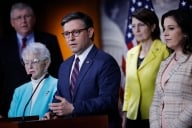You have /5 articles left.
Sign up for a free account or log in.
Remember MOOCs?
They were supposed to put us all out of business. The idea was that they represented the logical conclusion of the “unbundling” of higher ed into its component parts, the better to allow students to assemble their own education.
At the turn of the decade, “unbundling” was big. As the internet made possible the “disintermediation” of various services, like booking travel, some very smart people started looking at what else could be unbundled, thereby unlocking value for the consumer. Higher ed seemed like a natural. And, to be fair, we’ve all endured lectures that might as well have been recorded.
But it didn’t turn out that way. The attrition rate for MOOCs as credit-delivery methods was over 90 percent; if my college had an attrition rate like that, it would have shut down years ago. Sebastian Thrun famously abandoned a MOOC experiment at San Jose State, claiming that the students there were too needy. It worked best, he said, with highly motivated students who are self-directed and have plenty of time to study. Which, of course, is also true of traditional higher ed. MOOCs found useful niches as supplements to traditional education -- I’m thinking here of Khan Academy -- as well as in corporate training. But the conceit that the major problem with higher education was “bundling” turned out to be false.
Bundling is back in fashion.
Systematic efforts to address students’ basic needs -- exemplified by the #RealCollege movement -- are a form of bundling. They package food, transportation, and childcare assistance into the college experience, in recognition that students aren’t just brains in vats.
The Guided Pathways movement is a form of bundling. Rather than turning students loose into a maze of complicated options, we’re acting more like the travel agents of bygone days, packaging options into, well, bundles. From the students’ perspective, that minimizes the odds of something going wrong, and it minimizes the strain of making dozens of small decisions. In places that have done it well, it has also had the salutary effect of forcing colleges to look closely at their own operations, and to realign schedules and class offerings so students can actually take them.
Even Open Educational Resources are a form of bundling. As anyone who has worked with OER knows, selection and curation are major components of doing it well. It’s a big internet; knowing what to select and how to put it together is where faculty come in. While OER can offer significant and welcome cost savings for students, they can also customize course materials to be exactly the way faculty want them. This is the polar opposite of autodidactism; it’s taking the faculty-as-guide model into the very guts of the books themselves.
From an equity perspective, the return of bundling makes a lot of sense. Those lucky few students with the economic and cultural capital to free-ride on other institutions -- I’m thinking here of the young Bill Gates and the young Steve Jobs -- might be able to do amazing things while skipping, say, distribution requirements. But most students don’t have those advantages. For students who don’t know what they don’t know, turning them loose on the internet with an exhortation to learn something isn’t likely to work.
Economic theory teaches us that the role of the firm is to reduce transaction costs. For students for whom those transaction costs -- whether in time, money, or know-how -- would be prohibitive, bundling is a lifesaver. By putting labs, professors, libraries, financial aid, and tutors all in one place and subsidizing the cost, we make it possible for students who aren’t independently wealthy to learn at a high level. Yes, we could do it better. But I’ll stack Brookdale’s course completion rate up against Coursera’s any day of the week.
Even some of the apparent irrationalities of bundling make sense, when you look at the alternatives. Enrollments in the social sciences, for instance, cross-subsidize enrollments in lab sciences. If we completely unbundled, lab sciences would be prohibitively expensive for most. Our model allows every student to follow their talents.
MOOCs have settled in to roles that make more sense, and that’s fine. But our politics, and our financial aid systems, are still built on the assumption that students are isolated monads. They aren’t. They’re complicated, flesh-and-blood people, with families and utility bills and lots of competing priorities. Bundling -- that is to say, behaving like institutions -- offers the less-advantaged students a better shot. I’m glad to see it come back. Now, I’d love to see that same awareness start to fan out to the rest of our politics...







